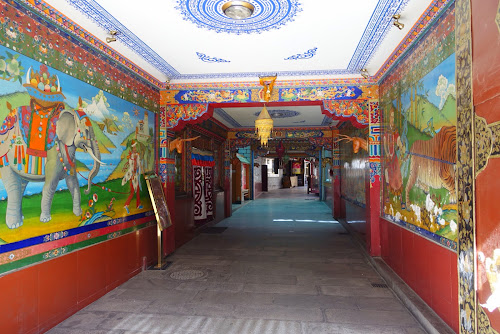Lhasa, Tibet - a personal story
I had, against the advise from my travel agent, booked a Tibetan 3 star hotel in the old town section, because tripadvisor rated this "Tashitagke hotel" higher than the hotel I was advised to book. As you all know, in exchange for having Sandee travel with carry-on only, I promised to lodge her in places with private bathroom and wifi. Well, after entering the place and struggling up the stairs gasping for air, she managed to exclaim: "from the sublime to the ridiculous"
(Beautiful passage way between streets)
I am at a loss, why she was complaining, although we had to change rooms, as the toilet was not functional, maybe because we had not timely read a sign instructing that the "used paper be deposited in a nearby wastebasket".
There was an extra never before mentioned element she was objecting to: the fact that there was no central heat in the room. There was an electric heater, but the radius of heat covered only a third of the room.
The room key activated power to the room, so off it went whenever we exited the room. So a new defrosting was required upon each re-entry. It must be said however, that the double bed in the new bedroom we were relocated to, had an electric blanket, and very heavy warm covers. I reminded her that we grew up in rooms like that without electric blankets and she said "speak for yourself". Obviously, it wasn't a winning argument since we moved the next day. Although I should have known at $40 a night some give would be required, just didn't know it would be heat!
Ah well, we moved to a huge 4 star hotel, owned by a Buddhist monastery, with central heat and a room that was twice as large, where, because it was not tourist season, we and a young guy from Singapore were the only guests, meeting each other in the huge hotel restaurant for breakfast every morning.
As you may know we are controlling our weight counting calories daily. We found in this 4 star hotel a scale in our room, although the battery had died. We asked for a new battery, only to be told they had none. We requested a working scale and got one from a different room, that also did not work. An exasperated desk clerk told us that we had to forget it, but they would keep looking for it. So we bought a battery and after installing it, they brought us a non electric scale, found somewhere. That is 4 star service after three days turmoil created by "difficult" guests. End result, we got to weigh ourselves.
In the evenings we strolled through the busy neighborhoods in search of restaurants. Yak meat is actually very tasty, but be warned to stay away from Tibetan tea, a salty milky/buttery substance. One needs to order "black tea" if available or "indian tea", the sweet milky variety, as one will learn fast.
Since Chinese written menus do not really work for us, we found restaurants with picture menus. You point at a picture in the hope that you have correctly identified the content. Sometimes yes, sometimes no. Part of the adventure of travel.
Lunches were easier as we had our guide tell us what our choices were. In general you will find no high cuisine here and rice and noodles are the main staple. Potatoes are a vegetable here and Bokchoy often the favored green. The protein on the plate is the smallest component of any chosen dish.
But then again, we were here not to delve into high cuisine, but to witness the Tibetan Buddhist culture and learn all about its proud history among which, about reincarnation and sky burials.
Did you know that still today, - and our guide in his thirties vowed to go that way too-, Tibetans offer their body up to the vultures as a "last giving back to nature act". There are holy sites high up in the mountains, where the final remains are offered up, and we were told, that nothing remains, not even bones after the vultures are done with you.
The seventeenth century rebuilt Potala palace towers above Lhasa and defines the city as sky towers and giant ferry wheels do elsewhere.
A few interesting English notices that may need interpretation:
(What does this mean and what do they sell?)




















































Comments
Post a Comment